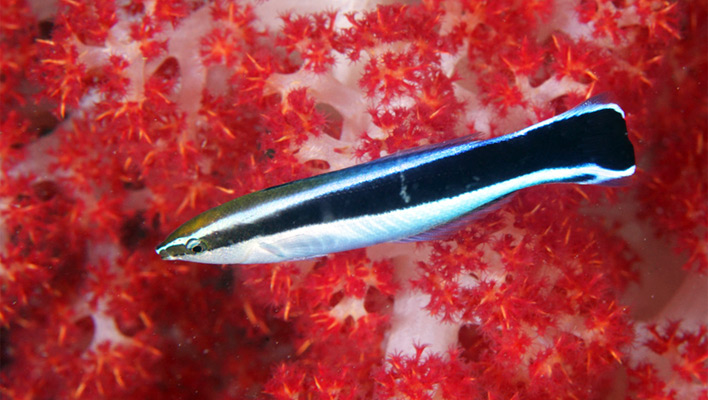“What do you mean the bluestreak cleaner wrasse is hard to keep? I once had one in my half-gallon pico tank for a year and a half, feeding it nothing but frozen brine shrimp and flake food, and it was as healthy as can be!”
If you’ve spent any amount of time in this hobby, you’ve probably heard similar assertions about success with notoriously hard-to-keep marine species—cleaner wrasses, ribbon eels, Moorish idols, Dendronephthya spp. corals, sea apples, and others—and wondered whether there was any truth to them.
I don’t doubt for a minute that some hobbyists succeed in keeping really challenging species alive and healthy. In fact, I know they do. But the trouble with such anecdotes as they apply to the average hobbyist is two-fold:
- They tend to create the false impression that the difficulties associated with keeping certain challenging species healthy for the long term are overstated (they usually aren’t).
- They raise the question, “If so-and-so succeeded with [insert name of preposterously difficult animal here], why shouldn’t I try it?”
Here are a few reasons you might want to think twice before attempting to keep any species that has a reputation for confounding even the experts:
Success is the exception
Some hobbyists who succeed with really challenging marine species are just exceptionally dedicated and willing to go to any lengths to meet the species’ unique requirements—for example, providing a steady supply of live stony corals to obligate-corallivore butterflyfishes, or serving up live starfish to harlequin shrimps. But even in these ideal circumstances, success with these animals is still hit-or-miss.
In other cases, the hobbyist might have simply lucked out in getting a specimen that just happens to be more hardy and adaptable than is typical for the species, e.g., a pinnate batfish that takes immediately to eating a variety of prepared foods. But again, such luck is the rare exception, not the rule.
True success is measured in years
One of the giveaways in my (admittedly exaggerated) example above is the length of time the fictitious hobbyist purportedly kept the specimen alive. Properly cared for, most marine fishes can live for many years in captivity—some for decades. In other words, a “success story” measured in months to a few years is nothing to brag about. I’ve seen starved fish cling to life for upwards of a year or even longer before finally giving up the ghost—and looking relatively healthy for much of that time.
What about corals and other sessile invertebrates? We can’t even really say how long they’re capable of living under the right circumstances. Could be indefinitely. Whatever their potential longevity may be, it’s safe to say that keeping a challenging species, such as a Tubastraea sp. coral, alive in an aquarium for merely a matter of months to a handful of years isn’t cause for celebration.
We have to know our limits
Before taking on the challenge of keeping any marine organism with highly specialized needs, we really must ask ourselves whether we have the willingness, ability, time, and resources to do whatever it takes to meet those needs for the duration of the animal’s potentially very long lifespan. If the answer to any part of that question is no, it’s best to leave the animal at your dealer’s—or, in some cases, in the ocean.




Coral reef fish are not particularly hard to breed and raise, it is just so much cheaper to collect them and that is a huge problem to someone who wants to start a fish breeding business.
You can get clownfish wholesale for five dollars, but if you had to raise one for a year to get it large enough to sell with the electricity and food costs along with the death rate, that five dollar clownfish may well be fifty dollars.
Very intresting blog.
I am myself intrested in tank bred species/aquacultured corals,and I hope people could see that some fish are made for the ocean and not for aquariums.
It doesnt need 10 years of experience to tell.It is obvious.
I wish there where more tank bred species availiable in the hobby.
Cheers!
Thanks for your kind comment and for sharing your thoughts, Alex. We’re definitely much further along with captive coral propagation than we are with the captive breeding of fish, but I think we’re moving in the right direction in that regard. More and more captive-bred species continue to hit the market with every passing year. Nonetheless, we still have a long way to go before captive-bred specimens surpass their wild-collected counterparts in the trade.
This is a good blog and as was stated, many people feel they are successful if they keep a particular fish for 2 or 3 years when in reality most fish we keep live well over 10 years and some such as clownfish, tangs, puffers and some others live over 20 years. The only fish that have a normal lifespan of 3 or 4 years are seahorses and pipefish, virtually all other fish live longer than that.
So to me, success is if you can keep a fish close to it’s normal lifespan which means if someone kept a clownfish for 25 years, it’s normal lifespan is probably close to that.
Another measure of success is if a fish is spawning or at least making spawning jestures as all fish spawn all the time. This will not apply to egg scatters like tangs as they will usually not spawn in a home aquarium but all gobies, pipefish, damsels, including clowns, and cardinals will spawn in a tank.
Thanks Paul! You have an excellent point about regular spawning being a good measure of success in addition to longevity.